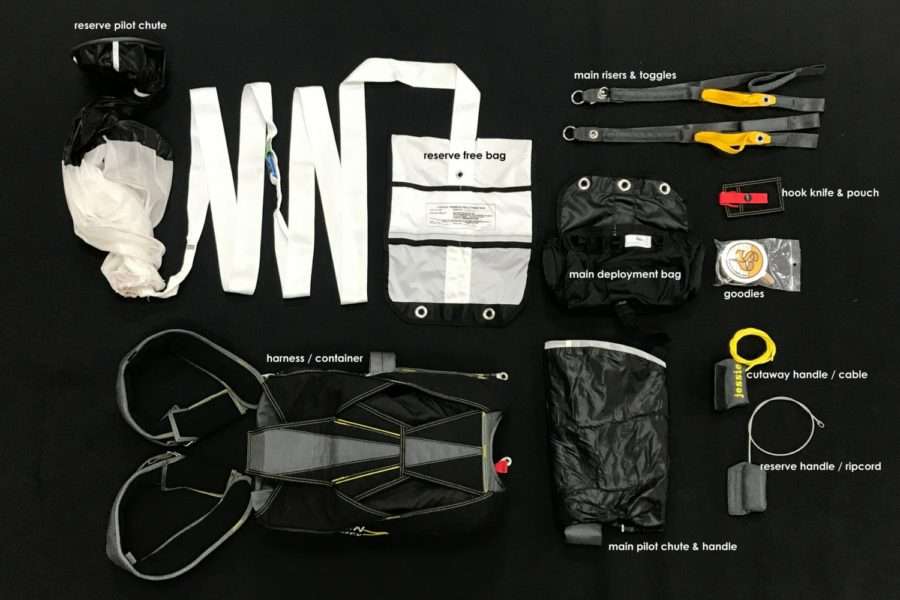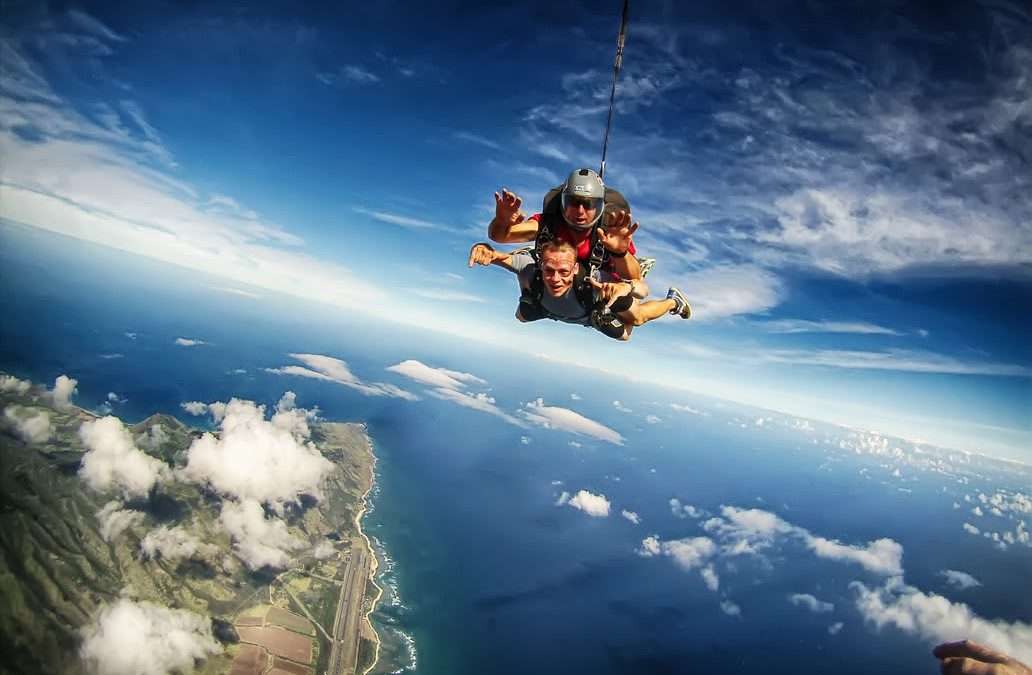
by Brett Newman | Apr 6, 2021 | Advice
The basics for skydiving safety you need to know before taking to the skies
For everyone who loves to skydive, safety is the absolute top priority. While we should all be mindful of safety precautions in every facet of our lives, when it comes to extreme sports, adhering to safety guidelines and protocols can significantly reduce the risk of injury or fatality. In this article, we’ve answered some of the most common questions asked about skydiving safety:
How safe is skydiving?
If you’re considering your first jump, you might be asking yourself whether skydiving is safe. The truth is that skydiving is an extreme sport, and like all extreme sports, it’s designed to test your physical and mental limits. Although extreme sports might be more daring than your average game of football or basketball, skydiving and activities like it are popular because they offer an adrenaline rush and sense of accomplishment unlike anything else.
The Australian Parachute Federation has been established for over 60 years and has been collecting records related to skydiving safety since its beginnings. The numbers show that skydiving is statistically safer than most extreme sports and that safety measures have only improved with time.
What’s the risk of fatality?
The most recent skydiving fatality rate reported by the APF is 1 in 100,000 jumps or 0.001%, which means statistically speaking, you’re at greater risk driving to work than during a skydive. In fact, you’re more likely to be hit by lightning than experiencing a malfunction during a skydive! Life is full of inherent risks, and the most important lesson is to therefore take measured, calculated steps to reduce your risk of harm.
In Australia, skydiving Drop Zone operators adhere to rigorous safety procedures, and students are encouraged to learn from instructors and ask plenty of questions before each and every jump. When you’re first learning to skydive, completing a tandem skydive with an experienced instructor will also help you to become more familiar with the sport.
How old do you have to be to skydive?
Skydiving age restrictions apply to protect both children and instructors. In Australia, the minimum age to skydive is 12 years old, provided the child has permission from a parent or legal guardian. Whilst there is no maximum cut-off age, there are certain health guidelines that may influence your ability to skydive.
If you have high blood pressure, diabetes, or other known medical conditions, speak with your doctor first, and then ensure you provide any relevant information to the skydiving company and instructor so everyone is aware and can take precautions. Medical professionals advise against skydiving whilst pregnant. Finally, it’s worth noting that maximum weight limits do apply to skydiving for safety reasons. The maximum weight to tandem skydive is typically 95- 100kg, but if you are learning to skydive you can weigh up to 110kg(speak to the drop zone when booking in for your training).
What should I wear while skydiving?
For your first few jumps, a full kit isn’t necessary. When tandem skydiving, wear comfortable, athletic and weather-appropriate clothing that will be not too bulky and loose for harnesses to fit around. However, when learning to skydive you will be provided with the appropriate jumpsuit, helmet, eyewear and skydiving equipment required for your training jumps.
A typical skydiving kit includes:
- Jumpsuit – designed to protect your body from the elements, such as cold air at high altitudes and assist you with flying your body during your jumps.
- Helmet – as with many other sports, helmets are used to protect your head from injury. Skydiving helmets are used to contain audible warning devices. There are both open face and full-face helmets(similar to motorcycle helmets).
- Goggles – are used to protect the eyes during your jump.
- Shoes – footwear should be comfortable and well-fitting to ensure they don’t come off in freefall and protect your feet during landings.
- Rig – a ‘rig’ is made up of 4 core elements, including the main canopy, reserve canopy, automatic activation device(AAD) and your harness/container system. The main canopy refers to your parachute. You will also have a backup parachute (the reserve) to deploy in the unlikely case of a malfunction or emergency.
Some Final Safety Tips
Your chosen skydiving drop zone operation and instructors will teach you how to safely enjoy skydiving. That said, safety is a shared responsibility and should be taken seriously. A few final notes on safe skydiving:
- Know and review your emergency procedures before every jump.
- Thoroughly check your equipment and rig before every jump.
- Always listen carefully to your instructor and follow their advice.
Enjoy the view! For more information on customised skydiving rigs, repacking and more, contact the friendly team at Downward Trend today. Phone 0400 011 331.

by Brett Newman | Mar 10, 2021 | Advice
We’ve scoured the web, spoken with veteran skydivers around the globe and evaluated our own experiences to come up with a definitive list of the best skydiving drop zones in the world. The team looked at factors such as weather, visibility averages, yearly availability, scenic beauty, drop zone accessibility and more to rank our top 10 spots.
We’re starting at the bottom at working our way up to the number 1 spot. Here we go!
10. Palm Jumeirah, Dubai
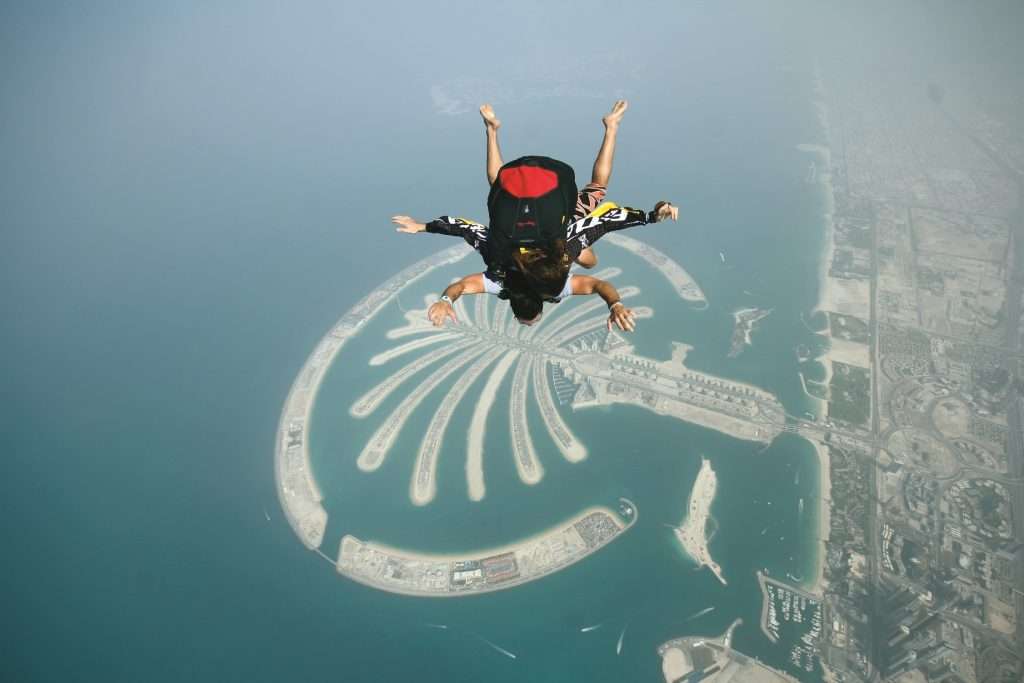
This incredible drop zone is seen in skydiving magazines around the world. The signature palm-tree-shaped islands provide a stunning backdrop in the Persian Gulf and a unique experience seeing this man-made feat from 14,000 feet.
It’s made our top 10 due to great accessibility – it’s one of only two city drops on our list. Although, because skydiving is so popular at this location, Dubai’s operators can book out quickly. If you’re planning a trip to Dubai, be sure to book in your spots days if not weeks in advance. One common drawback we hear about is reduced visibility and low hanging clouds, which could be a huge bummer if you’re only in Dubai a short while. Plan accordingly!
9. Mount Everest, Nepal

Arguably one of the most famous drop zones in the world, Mount Everest and the Himalayan mountains have been hosting skydivers since extreme sport around the area became popular and more accessible to the masses. The beauty and sheer scale of this drop zone cannot be understated. Being one small human surrounded by the largest mountain range in the world is nothing short of humbling, and the experience will surely provide memories lasting a lifetime.
A drawback of the area has to be its climate. With snowy peaks, difficult terrain and wind conditions, you may have to wait weeks if not an entire season to get a good forecast. Oh, and it’s also quite chilly at these altitudes. Pack those insulated jumpsuits!
8. Mysore, India

Credit: Reddit Images
From Nepal, we’re heading south to India to reach number 8 on the countdown. While it’s not as famous as the previous two drop zones on the world stage, it’s truly a hidden gem of Asia. Mysore (Chamundi Hills) is renowned for lush green forest views and beautiful patterns of ancient ruins scattered atop hills.
If you are travelling through India, it’s an absolute must! Although unless you’re in the relative area, it’s fairly difficult to get to just on its own. We also recommend avoiding monsoon season in the region (June – October) for the best chance at favourable conditions.
7. Namib Desert, Namibia
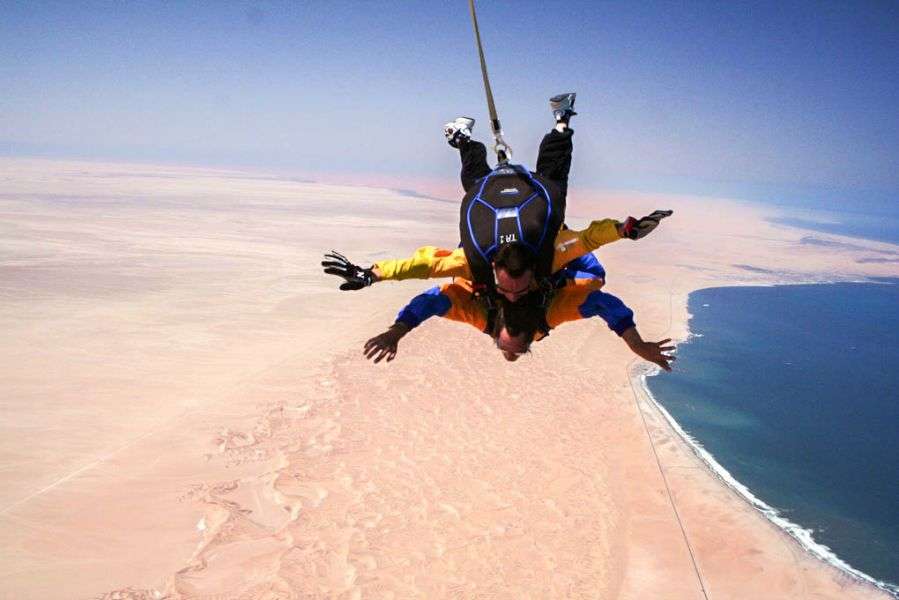
Credit: Backpacker Travel
If you’re searching for a drop zone unlike any other, look no further than the Namib Desert in Namibia. Surrounded by desert and rolling dunes for as far as the eye can see coupled with the stark contrast of the sand colliding with the sea makes for one incredible jump.
This drop makes our list for its sheer uniqueness and breathtaking scenery. Just like number 8, it’s pretty far out of the way unless you’re already touring the region. Although personally, we think it’s worth planning an entire trip around.
6. Voss, Norway
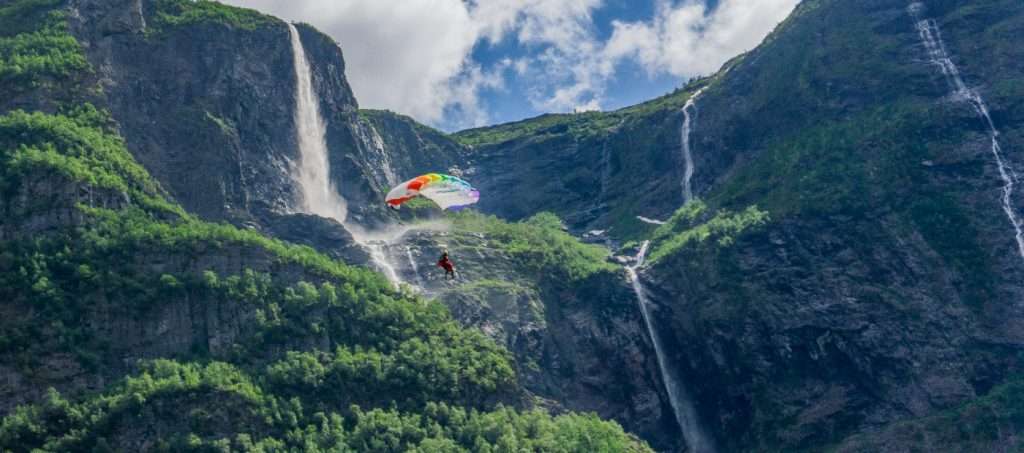
Credit: Skydiving Voss
We’re heading to Northern Europe for the 6th spot on our list – to Fjordland no doubt! Voss, Norway is famous for the wide range of extreme sports it accommodates and the stunning scenery of the region. The fjords provide an unparalleled, rugged landscape mixed with the clear glacial waters in the rivers and bays. Pure bliss, if you ask us!
For the drop zone itself, it’s only an hour from the popular Norwegian city of Bergen which makes it fairly accessible. However, being in Northern Europe, the season is limited to the hemisphere’s summer months starting at the end of April and ending in the middle of September.
5. Rio De Janeiro, Brazil
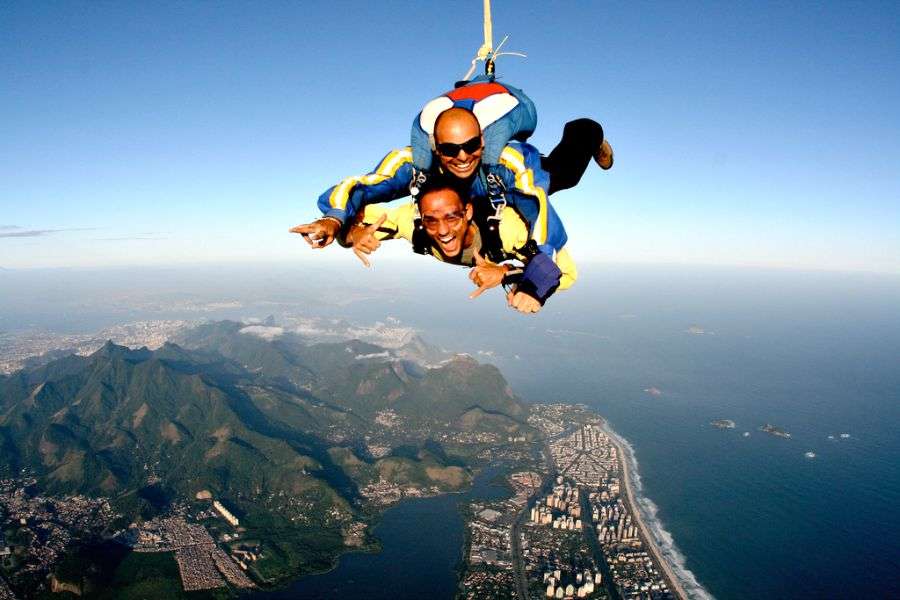
Credit: Backpacker Travel
There’s just something about Rio – the sun, the sand, the vibrance. The city is just brimming with the air of possibility, adventure and stunning scenery. That’s why it’s made number 5 on our list. Skydiving in Rio gives you views of the city most tourists only see from land – including Christ the Redeemer, Sugarloaf Mountain and Copacabana Beach. In 2017, the city even gained the first UNESCO World Heritage title for urban cultural landscape.
Rio is popular with skydivers, especially on good weather days. We’ve heard there can be long wait times for jumps and occasional disorganisation amongst the operators, so be prepared to wait and stay flexible with your plans.
4. Lauterbrunnen Valley, Switzerland

Credit: Bus to Alps
We couldn’t create a top 10 drop zones list without mentioning the Alps! The Lauterbrunnen Valley provides the perfect backdrop for one of the most beautiful skydiving spots in the world. Gorgeous green valleys, quaint mountainside villages and snowy peaks all await you in Switzerland. Top your afternoon off with an ice-cold beer looking out to the mountains and you may never have a better day.
Just like our other colder destinations, the season is more limited in Lauterbrunnen, and Switzerland is known for being quite expensive as a destination for skydiving and adventure sport.
3. Queensland, Australia (Mission Beach to Gold Coast)
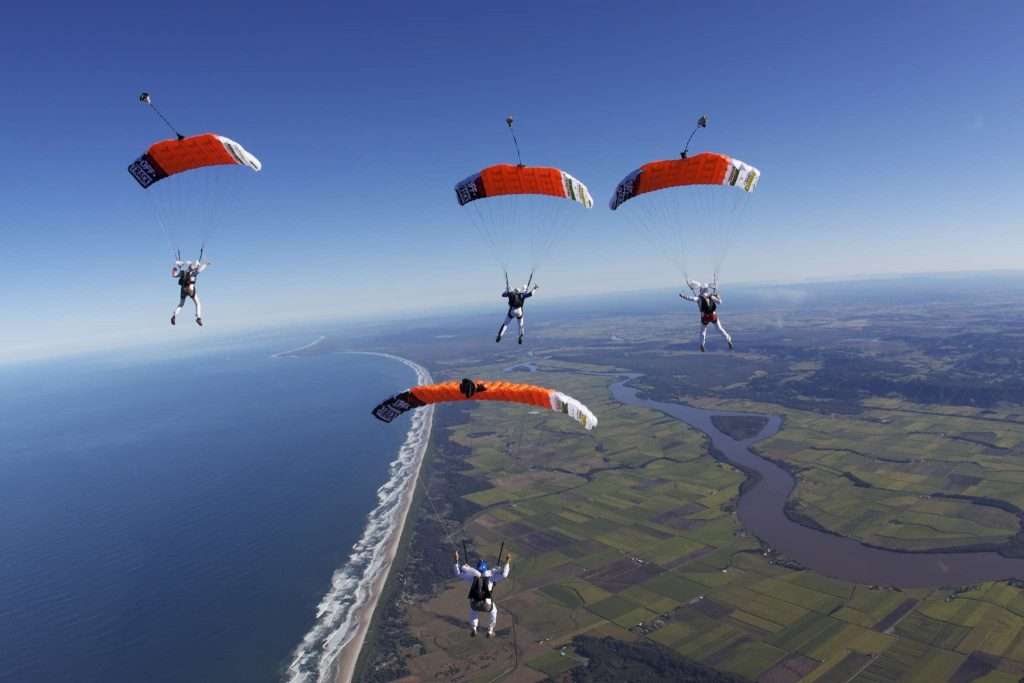
We couldn’t possibly choose just one area in our home state of Queensland for this list. We’re all too familiar with the incredible drop zones littered up and down our gorgeous coastline and each seems to be more spectacular than the next. On the Gold Coast, anywhere from Surfers Paradise to Tweed Heads, and further south to Byron Bay, offer some of the most pristine, yet accessible coastline. And then way up in North Queensland, lies the area next to the Great Barrier Reef. If you skydive from Mission Beach, you can see not one but two UNESCO World Heritage sites – the Reef and Daintree Rainforest!
The best part about Queensland is you can skydive here year-round. We are one of the sunniest regions on the entire planet, so you can bet you’ll find a beautiful backdrop for your skydive.
2. Grand Canyon, Arizona, USA

Credit: Skydive Grand Canyon
Making the number 2 spot on our list is none other than the Grand Canyon in the ol’ US of A. As another World Heritage site, there’s a reason millions of tourists flock to this location every year to explore the awe-inspiring red vistas of this national park. But a way most people never get to experience it is from above!
To understand its size, the Grand Canyon spans a whopping 4,931 square km, which is larger than the US state of Rhode Island! Skydiving from this spot is truly an immersive experience you’ll never forget. And with hundreds of drop zones between the Grand Canyon and California, you can access this beautiful part of the world fairly easily. Being in the southern region of the United States, also makes skydiving here possible for much of the year.
1. Fox Glacier, New Zealand
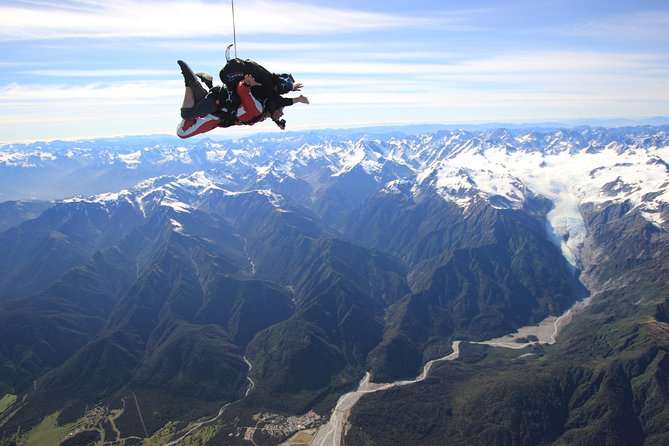
Credit: Viator
We have reached our number 1 spot, and it’s none other than the adventure capital of the world – New Zealand. For being a small country, it has an extraordinarily diverse landscape – mountains, beaches, glaciers, lakes, fjords – the list goes on! This diversity is why we have given the number one spot to Fox Glacier!
As you plummet towards the glacier, you will be overcome by the sheer scale of the surrounding landscape and find a peaceful serenity as you float back to earth. Many people say this is their favourite drop in the entire world, and we see why! It’s truly a skydiver’s paradise.
___
What a ride it’s been exploring these drop zones around the globe for you! We’d love to hear if you’ve jumped any or many of these incredible places on the list. If not, well, we’ve just created the ultimate skydiving bucket list for you.
And finally, if you’re based locally here in Australia and need any equipment or rigging services, be sure to get in touch with Downward Trend. Brett and the team have been skydiving for over 30 years, and we are passionate about keeping skydivers having fun in the safest equipment available.
Wishing you endless clear skies!
Phone
0400 011 331
Email
brett@downwardtrend.com.au

by Brett Newman | Feb 1, 2021 | Advice
So you’ve made those first few jumps, felt the unequalled exhilaration of freefall, the signature pump of adrenaline through your veins, landed back on earth but not quite the same and now… you’re hooked on skydiving. Whether you’ve been using rental or borrowed equipment, it’s now time to get some gear of your own. After all, it’s more than a hobby, it’s a lifestyle! There are many considerations for purchasing your first set of skydiving gear, and it’s important to get it right both for safety and cost considerations.
You probably have many questions – should I buy new or used? What are the considerations when purchasing a rig? We’re going to cover all the basics, so you’ve come to the right place.
Let’s start at the top.
1. Helmet and Goggles
A hard shell helmet is a mandatory requirement during the early stages of your skydiving career, so getting a correctly sized and comfortable helmet to fit your noggin is essential. Clean and clear goggles are important as you want to have a good field of view. The helmet should fit well and remain snug to your head with an accessible, but secure clasp.
We recommend buying these two items new, as they will be in close contact with your face, but often you can purchase good secondhand helmets. They also won’t set you back too much on price, so it’s worth investing in something quality you’ll have for a long time. Seek advice from your Instructor or DZ owner/operator on quality brands.
2. Jumpsuit
A good jumpsuit serves many purposes. The right tool for the right job! Firstly, it offers a basic level of protection from scratches and abrasions that occur… especially on landing! Secondly, it can help control fall rate, assist in directional control and provide hand grips for group jumps.
If you’re just starting out, a jumpsuit is something you can purchase used (if you find one that’s a good fit.) As a new skydiver, it’s also worth investing a little time in researching what jumpsuit best suits your body type and weight as the wrong jumpsuit can really negatively affect your jumps.
3. The Rig
A rig is what separates you from Tom Cruise jumping out of a plane in just a t-shirt and aviators. Your rig is your lifeline and your most important piece of skydiving gear, so it’s worth investing quite a bit of time researching to find one suited to you and your experience level.
A rig consists of a:
- Container / Harness system (the backpack that holds the canopies)
- Reserve canopy
- AAD (Automatic Activation Device)
- Main canopy
– Canopies
We could go on about choosing canopies for an entire article, but for now, the most important aspects to consider are your experience level and weight which will determine the best canopy for you. Your instructors will tell you that you’ll need to demonstrate canopy control with lower wing loading before moving to a smaller canopy. Instructors or riggers (like us here at Downward Trend) will be your best guide for buying these.
*Tip: Never buy your first canopy without consulting experienced people in the sport.
– Harness/Container
A harness/container is the backpack that your canopies are packed into with a harness that holds the container onto your body. The most important thing when buying a harness/container is having a harness that fits your body and the right size for the canopies you will be using. Don’t buy your harness/container before you confirm what size canopies you will be using as there are many different sizes of harness/containers and each model is designed to hold specific size canopies.
– Automatic Activation Device (AAD)
The AAD is an essential piece of equipment when starting out in skydiving. The AAD is a backup device that has a preset activation altitude and will initiate the deployment of your reserve parachute if you have not activated your main or reserve canopy before you reach this preset altitude. If you have an incident that may cause you to lose consciousness or even just lose track of your altitude, the AAD can literally save your life!
4. Altimeter and Audible Altimeter
Your altimeter is a mandatory piece of equipment that measures your altitude above the ground so you know when to deploy your canopy. There are many reputable altimeters on the market, and most manufacturers provide both visual altimeters and audible altimeters. Visual altimeters are usually worn on your wrist and audible altimeters are worn in your helmet and beep in your ear! Usually, a skydiver will only have to make this purchase once or twice in their life, so we recommend investing in a quality one that’s easy for you to read… you know… while falling through the sky.
New or Used Skydiving Gear?
There’s no way around it, skydiving gear is expensive. While new gear is custom made and tailored to your exact needs, a completely new set-up can cost you anywhere from $10,000 AUD to upwards of $13,000 AUD or more. Luckily, there is a great secondhand market in Australia, and you can normally find good quality gear from around $5,500 to $7,500.
If you are going to buy used gear, our one request is that you have it inspected by a trusted rigger prior to purchase. Remember, if a deal seems too good to be true, it probably is.
Downward Trend is here to help
At Downward Trend, we live and breathe skydiving equipment and would be happy to walk you through the ins and outs of purchasing your gear. Brett and the team have been skydiving for over 30 years. Along the way, we’ve picked up a thing or two, so come in have a chat, and we’ll be sure to sort you out.
Phone
0400 011 331
Email
brett@downwardtrend.com.au
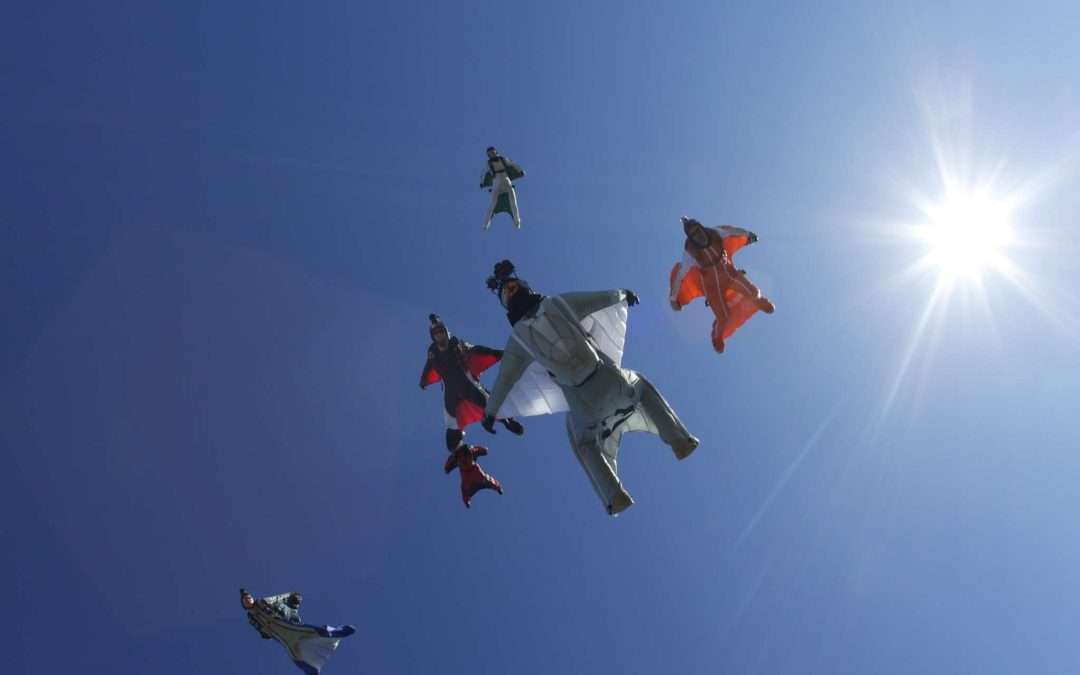
by Brett Newman | Feb 7, 2020 | Advice
Can’t get enough of that jump?! We know the feeling! At Downward Trend, we understand what you need as a new skydiver to both get started and grow in the sport. We’ve got over 20 years of experience and a set of experts ready to guide you no matter your level. If you want to get into skydiving, then here’s where to get started:
1. Begin Skydiving Lessons to get your Cert A
You’ve jumped before, fallen (literally) head over heels for the sport and now you know it’s time to get lessons so that you can get your Cert A skydiving license. You’ll need to get your license through an AFF course (accelerated freefall course) or a solo jump course. You can find a Training Drop Zone on the Australian Parachute Federation (APF)’s website.
2. What is Accelerated Freefall?
With Accelerated Freefall, you’ll start out right in the action, as you’ll be freefalling from your first jump. Considered the more modern training method in the skydiving community, you will complete a minimum of 9 AFF training jumps before you can receive your Cert A. With AFF, your freedom starts right away as you’ll get to freefall anywhere between 10,000 and 15,00 ft with two instructors known as jumpmasters that stay with you from the moment you jump, right up until your parachute deploys. Talk about exhilarating!
3. What is a Solo Jump Course?
Solo Jump Courses start at lower altitudes and allow you to concentrate on your parachuting skills first before you work your way up to a free fall. The first stages of this course will mean that your parachute will be opened for you by an instructor or a line attached to the plane known as a static line. Each jump focuses on developing new skills – from stable free-falling to all kinds of maneuvers like 360s or backflips. This course builds great basic skills that you will carry throughout your development in the sport.
4. What course do I pick?
Whether you want to jump right in or would feel more comfortable with a more gradual build in becoming a skydiver, both the AFF and solo jump course are great options for getting your Cert A. The important thing when starting out is finding a drop zone in a local area where you’ll sit your certification courses. The APF have a list of drop zones and chief instructors who can walk you through the courses on offer. Of course, if you get stuck, speak to the team at Downward Trend and we’ll provide you with our favourite course locations and instructors or explore our site for more information. We would love to hear from you!

by Brett Newman | Sep 2, 2019 | Advice
Even for the most experienced of skydivers, there’s always something to learn when it comes to your gear. For newer divers, we know that the first step in getting the right gear is understanding it, which is why we’ve put together a list of the following critical terms. As an added challenge, see if you can define each item before reading the definition!
Skydiving Terms to Know
Altimeter – The instrument used to measure the altitude you’re at.
AAD – Automatic Activation Device. This gadget is a must for all skydivers, the AAD detects the altitude and speed of your decent. This piece of equipment is designed to fire and open your reserve parachute automatically.
Canopy/main – The canopy is the largest parachute in your rig often referred to as the main.
Container – Like a backpack, the container holds your main parachute, reserve parachute and your AAD.
Closing loop and closing pin – Hold the container closed until you release it.
Chop/Cutaway – where you release the main parachute
Drogue – A smaller parachute often used in tandems to help stabilise and slow down the freefall.
Goggles – Used to protect your eyes during freefall.
Handles – Handles are a part of your skydiving rig. One set cuts away the main parachute and the other activates your reserve.
Helmet – Used to keep your head protected from injury from bumps that can occur from the plane or other skydivers.
Jumpsuit – Jumpsuits can aid in controlling your fall speed as well as provide better grip when performing maneuvers with other jumpers.
Pilot Chute – a small auxiliary parachute that is attached to the main parachute used to deploy the main or reserve parachute.
Reserve – this crucial piece of equipment is your back-up parachute if something doesn’t go to plan with your main parachute.
Three-ring – a release system that allows for an easier deployment of the main parachute and an easier switch to the reserve if needed.
There you have it. If you know these gear terms inside and out, it’s a good sign you’ve advanced in your skydiving knowledge. When it comes to skydiving, the learning never stops!













